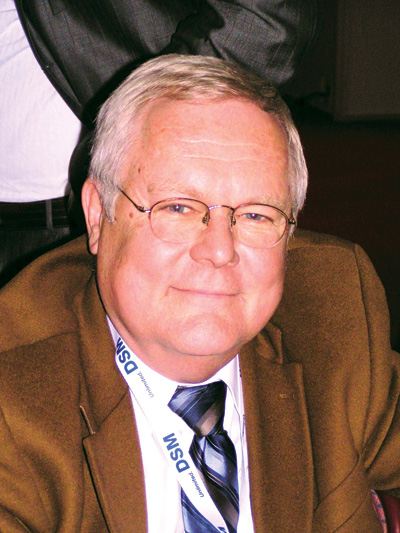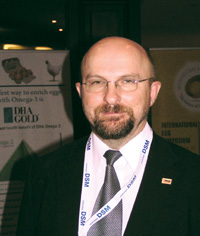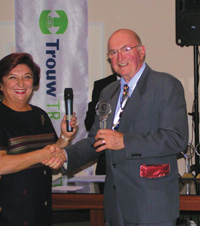
Return of the Good Egg
By Dr. Peter Hunton
Features New Technology ProductionOvercoming Past Misconceptions
In late November 2008, more than 100 scientists gathered in Istanbul,
Turkey, for the symposium, “The Return of the Good Egg.” Keynote
speaker Don McNamara, from the U.S. Egg Nutrition Center in Washington,
D.C., reviewed the sad history of what he called a failed hypothesis
People beginning to realize negative effects of reducing consumption of eggs.
 |
|
| Getting it Right Don McNamara, from the U.S. Egg Nutrition Center in Washington, D.C., reviewed the sad history of the alleged relationship between cholesterol in our diet and cholesterol in our bloodstream, and consequentially, our risk of heart disease. Photo by Dr. Peter Hunton Advertisement
|
In late November 2008, more than 100 scientists gathered in Istanbul, Turkey, for the symposium, “The Return of the Good Egg.” Keynote speaker Don McNamara, from the U.S. Egg Nutrition Center in Washington, D.C., reviewed the sad history of what he called a failed hypothesis, vis the alleged relationship between cholesterol in our diet and cholesterol in our bloodstream, and consequentially, our risk of heart disease.
Although the original statements about cholesterol’s bad effects on human health were made more than 25 years ago, it is only now that people are beginning to realize the negative effects that reducing consumption of eggs has produced.
Dr. McNamara quoted the well-known American philosopher and humorist, H.L. Mencken, who once said that “for every problem, there is a solution that is simple, neat and wrong.” So for many medical doctors, faced with a patient who was overweight, under-exercised and with a high blood cholesterol level, it became easy to recommend that they reduce or cease egg consumption. Although unlikely to resolve the patients’ problems, it still more or less met the physicians’ pledge to “do no harm.”
There is now more than enough evidence, from animal studies, clinical trials and epidemiological studies, to convince anyone that there is no statistical relationship between egg consumption and risk of heart disease.
The difficulties and shortcomings of animal models were described. Herbivores such as rabbits (used in the original work quoted to demonstrate the effect of dietary cholesterol on blood cholesterol) are of little value, because in their natural diet, they do not encounter cholesterol. Work using dogs or rats, while of potentially greater value, is often invalidated because of the very high levels of cholesterol used. These are often so high as to overwhelm the animals’ natural control mechanism.
 |
|
| Dr. Peter Surai of Alltech said inhabitants of many European and Asian countries are generally deficient in selenium because of local soil conditions. Photo by Dr. Peter Hunton |
|
 |
|
| Prof. Ruveyde Akbay, president of the Turkish Branch, World Poultry Science Association, presents a memento of attendance to Dr. Peter Hunton. Photo by Dr. Peter Hunton |
Epidemiological studies have perhaps provided the best data confirming the lack of association between consumption of eggs (or other cholesterol-containing foods) and the risk of heart or artery disease. Once data are corrected for patient age, and other variables, it is clear that there is no connection; however, demonstrating this is only the first step. Informing the public and, more importantly, the medical and nutrition communities is more difficult, time-consuming and expensive.
The Turkish organizers played an important part locally by holding a press conference prior to the main symposium, and hoped to achieve wide media coverage. This included presentations by Don McNamara and a local physician, respected in the Turkish medical profession. The press conference was attended by almost 100 people including television, radio, magazine and newspaper personnel.
McNamara and his U.S. colleagues work tirelessly to promote the message in their own media.
The next phase of the promotion of the “New Good Egg” is the emphasis on the aspects of egg nutrition that consumers deny themselves by restricting egg intake. These include the benefits of choline, lutein, folic acid and omega-3 fatty acids, all contained in normal eggs, and in greater quantities in some of the enriched eggs now on the market.
Dr. Peter Surai is a world traveller on behalf of Alltech, manufacturers of Sel-Ple, which, when added to the diet of laying hens, increases their selenium content three- to five-fold. Enriched eggs provide 20 to 30 per cent of the supposed requirement of many people, although recommended levels vary in different countries. According to Dr. Surai, inhabitants of many European and Asian countries are generally deficient in selenium because of local soil conditions. North Americans are less likely to be deficient.
There were several papers reporting original research on supplementing eggs with omega-3 fatty acids, along with other nutrients that might prevent oxidation of these relatively unstable compounds. Customizing eggs for different functional and nutritional needs was discussed by Dr. Niva Shapira, from Tel Aviv University in Israel. Dr. Shapira also discussed the ration of omega-6 and omega-3 fatty acids, which has become much wider in contemporary western diets than in, for example, the diets of our hunter-gatherer ancestors. This factor has been exploited by the producers of Columbus Eggs, developed in Belgium, but now widely available around the world.
Another interesting paper was presented by Dr. Gilbert Weber of DSM, not directly dealing with eggs, but with the nutrition of hens producing them. Dr. Weber showed that many of the recommendations for vitamin nutrition of layers are based on research conducted at least 30 years ago. Since then, layers have become much more productive, and have reduced their feed consumption by 10 to –20 per cent. All of the vitamins were discussed with respect to their function, and symptoms of deficiency. Recommendations from the NRC (1994) were compared with current usage by DSM and other vitamin suppliers. Compared with the 1994 recommendations, vitamin A levels are now increased three-fold, vitamin D3, 10-fold, and other essential vitamins by multiples varying from double to 10-fold.
Other research reported included feeding hens a yeast autolysate, which increased egg weight by about 0.7g/egg and altered the fatty acid and cholesterol composition.
French researchers described exciting new research to identify new egg proteins. This work is in its infancy but promises to yield new outlets for egg components of value in the medical and pharmaceutical fields.
All told, this symposium was an excellent advertisement for eggs, and an exciting look into the future of what many believe is already “nature’s perfect food.”
* Dr. Hunton’s attendance at the symposium in Istanbul was funded by ISA, a Hendrix Genetics Company.
Print this page